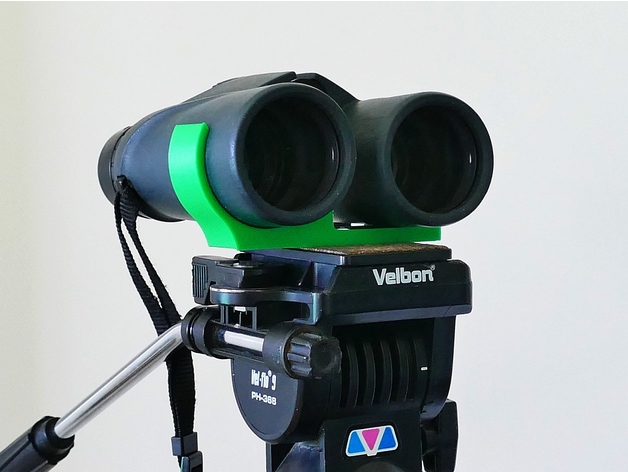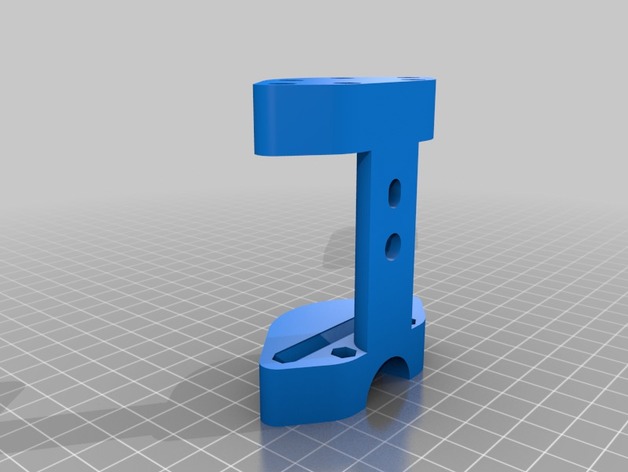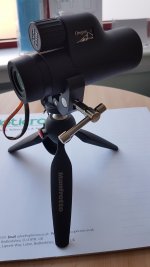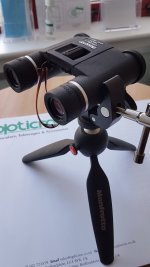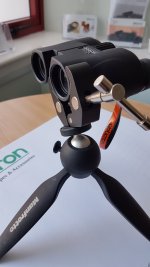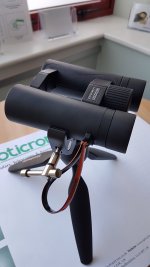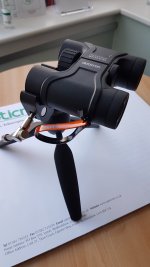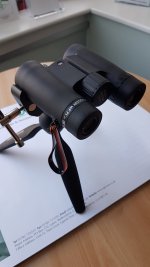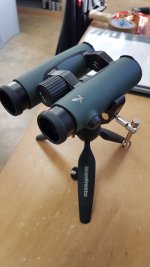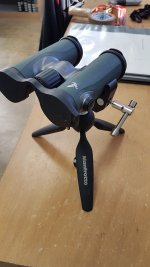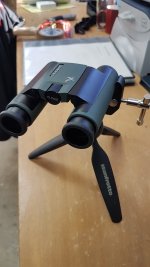The relaxing view achieved by putting a binocular on a support can be something of a revelation and, for magnifications of about 12x upwards, a support is almost a necessity.
A tripod will eliminate all six degrees of freedom and a monopod will eliminate vertical movement and restrict some of the others, in particular pitch and roll, to use the nautical terms.
For the monopod a simple tilt head like the Manfrotto 234 or Sirui L10 is all that's needed, but the tripod will require a friction ball head with panorama function or, better still, a 2-way video head.
Apart from amateur astronomy and boosted resolution measurements, a tripod can be useful in some birding situations. At one particular site where a stretch of water is inaccessible I have often set up my 10x bins on a second tripod next to the scope just for long-term observation of what flies in, and have then switched to the scope for a closer look or ID.
Disregarding the Manfrotto clamp (I would be a little wary of using this), binocular adapters can be divided into hinge type and platform type. Many Porro and roof prism binoculars have a 1/4"x20 female thread at the front of the hinge, which allows the attachment of an adapter with a knurled screw. A disadvantage with roof prism binoculars with large objectives is that the minimum IPD is often increased, making them unsuitable for some users. A variation is the attachment of a stud to the front thread allowing the binocular to be fixed to the adapter via a flip lever. This was used with the 15x60 Docter Nobilem, Swarovski 15x56 SLCs andthe Outdoorsmans adapters.
Some hinge adapters clamp around the hinge tube like the dedicated adapter for the Nikon WX. This particular one though is very flimsy and vibration prone. Why mill out parts of the adapter to save weight, when the binocular weighs 2,5 kg?
Platform adapters are a practical solution for roof prism bins and the only disadvantage is that the IPD cannot be adjusted when they are mounted. I have used the Leica adapter for many years and it allows very rapid attachment. There are two wide "V"s front and rear to position the right barrel. The left barrel rests on a neoprene pad and the binocular is secured with a rubber strap. It will take anything from an 8x32 (the 8x30 CL is too small) up to a 15x56 Conquest HD, which was literally a bit of a stretch. Contrary to some comments I have read, the Leica provides a very secure and stable base.
The Swarovski UTA (universal tripod adapter) is similar but apparently only recommended up to 42 mm. It has an integral Arca-Swiss compatible foot.
The Zeiss Binofix is IMHO not very well thought out and is much too expensive. Years ago I wanted to check out a 15x56 SLC Neu and the dealer couldn't find the dedicated adapter. We tried fitting it via a Binofix but couldn't secure it firmly. It also places the centre of gravity much too high, increasing the danger of flopping over centre.
In anticipation of getting an 8x56 SLC I ordered the Berlebach adapter. It turned out that the big SLC can be fitted quite comfortably to the Leica adapter and that it is prone to rock on the flat rubberized roof surfaces of the Berlebach. It would be OK for bins with cylindrical or straight tapered barrels but perhaps Berlebach should remove some material from the centre to provide a firm location for bins with curved barrels.
It would be interesting to hear of other user's experiences.
John
A tripod will eliminate all six degrees of freedom and a monopod will eliminate vertical movement and restrict some of the others, in particular pitch and roll, to use the nautical terms.
For the monopod a simple tilt head like the Manfrotto 234 or Sirui L10 is all that's needed, but the tripod will require a friction ball head with panorama function or, better still, a 2-way video head.
Apart from amateur astronomy and boosted resolution measurements, a tripod can be useful in some birding situations. At one particular site where a stretch of water is inaccessible I have often set up my 10x bins on a second tripod next to the scope just for long-term observation of what flies in, and have then switched to the scope for a closer look or ID.
Disregarding the Manfrotto clamp (I would be a little wary of using this), binocular adapters can be divided into hinge type and platform type. Many Porro and roof prism binoculars have a 1/4"x20 female thread at the front of the hinge, which allows the attachment of an adapter with a knurled screw. A disadvantage with roof prism binoculars with large objectives is that the minimum IPD is often increased, making them unsuitable for some users. A variation is the attachment of a stud to the front thread allowing the binocular to be fixed to the adapter via a flip lever. This was used with the 15x60 Docter Nobilem, Swarovski 15x56 SLCs andthe Outdoorsmans adapters.
Some hinge adapters clamp around the hinge tube like the dedicated adapter for the Nikon WX. This particular one though is very flimsy and vibration prone. Why mill out parts of the adapter to save weight, when the binocular weighs 2,5 kg?
Platform adapters are a practical solution for roof prism bins and the only disadvantage is that the IPD cannot be adjusted when they are mounted. I have used the Leica adapter for many years and it allows very rapid attachment. There are two wide "V"s front and rear to position the right barrel. The left barrel rests on a neoprene pad and the binocular is secured with a rubber strap. It will take anything from an 8x32 (the 8x30 CL is too small) up to a 15x56 Conquest HD, which was literally a bit of a stretch. Contrary to some comments I have read, the Leica provides a very secure and stable base.
The Swarovski UTA (universal tripod adapter) is similar but apparently only recommended up to 42 mm. It has an integral Arca-Swiss compatible foot.
The Zeiss Binofix is IMHO not very well thought out and is much too expensive. Years ago I wanted to check out a 15x56 SLC Neu and the dealer couldn't find the dedicated adapter. We tried fitting it via a Binofix but couldn't secure it firmly. It also places the centre of gravity much too high, increasing the danger of flopping over centre.
In anticipation of getting an 8x56 SLC I ordered the Berlebach adapter. It turned out that the big SLC can be fitted quite comfortably to the Leica adapter and that it is prone to rock on the flat rubberized roof surfaces of the Berlebach. It would be OK for bins with cylindrical or straight tapered barrels but perhaps Berlebach should remove some material from the centre to provide a firm location for bins with curved barrels.
It would be interesting to hear of other user's experiences.
John






